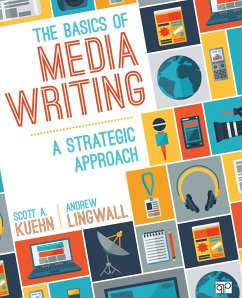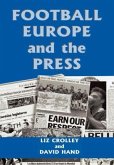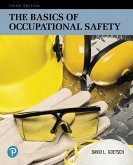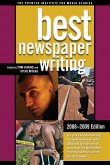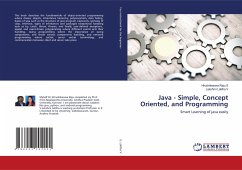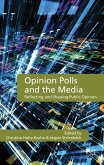- Broschiertes Buch
- Merkliste
- Auf die Merkliste
- Bewerten Bewerten
- Teilen
- Produkt teilen
- Produkterinnerung
- Produkterinnerung
The Basics of Media Writing: A Strategic Approach helps readers develop the essential writing skills and professional habits needed to succeed in 21st-century media careers. This research-driven, strategy-based media writing textbook digs deeply into how media professionals think and write in journalism, public relations, advertising, and other forms of strategic communication. Authors Scott A. Kuehn and Andrew Lingwall have created two comprehensive writing models to help students overcome their problems in finding and developing story topics by giving them starting points to begin writing.…mehr
Andere Kunden interessierten sich auch für
![Global Writing for Public Relations Global Writing for Public Relations]() Arhlene A FlowersGlobal Writing for Public Relations235,99 €
Arhlene A FlowersGlobal Writing for Public Relations235,99 €![An Introduction to Trading in the Financial Markets: Market Basics An Introduction to Trading in the Financial Markets: Market Basics]() R. Tee WilliamsAn Introduction to Trading in the Financial Markets: Market Basics30,99 €
R. Tee WilliamsAn Introduction to Trading in the Financial Markets: Market Basics30,99 €![Football, Europe and the Press Football, Europe and the Press]() Liz CrolleyFootball, Europe and the Press131,99 €
Liz CrolleyFootball, Europe and the Press131,99 €![The Basics of Occupational Safety The Basics of Occupational Safety]() David GoetschThe Basics of Occupational Safety214,99 €
David GoetschThe Basics of Occupational Safety214,99 €![Best Newspaper Writing Best Newspaper Writing]() Tom HuangBest Newspaper Writing71,99 €
Tom HuangBest Newspaper Writing71,99 €![Java - Simple, Concept Oriented, and Programming Java - Simple, Concept Oriented, and Programming]() Hrushikesava Raju S.Java - Simple, Concept Oriented, and Programming55,99 €
Hrushikesava Raju S.Java - Simple, Concept Oriented, and Programming55,99 €![Opinion Polls and the Media Opinion Polls and the Media]() Opinion Polls and the Media76,99 €
Opinion Polls and the Media76,99 €-
-
-
The Basics of Media Writing: A Strategic Approach helps readers develop the essential writing skills and professional habits needed to succeed in 21st-century media careers. This research-driven, strategy-based media writing textbook digs deeply into how media professionals think and write in journalism, public relations, advertising, and other forms of strategic communication. Authors Scott A. Kuehn and Andrew Lingwall have created two comprehensive writing models to help students overcome their problems in finding and developing story topics by giving them starting points to begin writing. The Professional Strategy Triangle model shows students how to think critically about the audience, the situation, and the message before starting a news story or persuasive piece and the FAJA four-point model asks students a series of questions about their story type (Fact, Analysis, Judgment, or Action) to guide them to the right angle or organizational structure for their message. Rooted in classical rhetorical methods, this step-by-step technique enables readers to strategically approach each writing task, no matter the format.
Produktdetails
- Produktdetails
- Verlag: CQ Press / Sage Publications
- 1. Auflage
- Seitenzahl: 568
- Erscheinungstermin: 2. März 2017
- Englisch
- Abmessung: 232mm x 187mm x 35mm
- Gewicht: 1020g
- ISBN-13: 9781506308104
- ISBN-10: 1506308104
- Artikelnr.: 47150429
- Herstellerkennzeichnung Die Herstellerinformationen sind derzeit nicht verfügbar.
- Verlag: CQ Press / Sage Publications
- 1. Auflage
- Seitenzahl: 568
- Erscheinungstermin: 2. März 2017
- Englisch
- Abmessung: 232mm x 187mm x 35mm
- Gewicht: 1020g
- ISBN-13: 9781506308104
- ISBN-10: 1506308104
- Artikelnr.: 47150429
- Herstellerkennzeichnung Die Herstellerinformationen sind derzeit nicht verfügbar.
Scott Kuehn, Ph.D. - is Professor of Communication at Clarion University of Pennsylvania. He earned his Ph.D. in Speech Communication at the Pennsylvania State University in 1987. Scott teaches courses in mass communication research, communication law, new media effects, social media for media professions, mass media criticism, and photography. His research focuses on the perceptions of communication skills and communication competence, has been published in Journalism and Mass Communication Educator and Communication Education. He currently serves as advisor for WCUC 91.7 FM, Clarion University¿s 3800 watt radio station. Scott is an amatuer photographer with expertise in medium and large format film photography. Scott is also a part time musician who records jingles and other radio, television, and cinematic music.
PREFACE
ACKNOWLEDGMENTS
ABOUT THE AUTHORS
SECTION I: MEDIA WRITING FOUNDATIONS
CHAPTER 1: YOU AS A WRITER
Welcome to Media Writing!
Media Consumption and Production, All at Once
Media Responsibilities and Challenges
The Role of Skilled Writing
Understanding Yourself as a Writer
The Media Writer's Self-Perception (MWSP) Scale
The Grammar, Spelling, Punctuation (GSP) Test
Summary
Key Terms
Discussion Questions
Chapter Exercises
Additional Resources
CHAPTER 2: MEDIA WRITING PROFESSIONS AND STRATEGIES
21st-Century Media: A Rapidly Changing Landscape
Overview of the Major Media Professions
Professional Media Writing Strategy
Using the FAJA Points in Your Writing
Summary
Key Terms
Discussion Questions
Chapter Exercises
Additional Resources
CHAPTER 3: MEDIA WRITING STYLE AND LANGUAGE CONVENTIONS
Style: Your Audiences Are Counting on It
Media Writing Style Conventions
The Connection Between Thinking and Writing
Style Guides
Selected Points of AP Style
Additional Language Rules
Grammar, Spelling, and Punctuation
Summary
Key Terms
Discussion Questions
Chapter Exercises
Additional Resources
SECTION II: NEWS SETTINGS
CHAPTER 4: REPORTING AND INTERVIEWING
Journalism: A Higher Calling
The First Amendment Guarantee
Professional News Writing Standards
The Converged Media Environment
Applying the Professional Strategy Triangle to Reporting
News Reporting
Interviewing
Summary
Key Terms
Discussion Questions
Chapter Exercises
Additional Resources
CHAPTER 5: HARD NEWS AND FEATURE WRITING
Versatility Is the Key
The Multiplatform Story
Writing the Hard News Story
Using Quotations
Writing the Feature Story
Summary
Key Terms
Discussion Questions
Chapter Exercises
Additional Resources
CHAPTER 6: ELECTRONIC NEWS WRITING: RADIO AND TELEVISION
The Electronic Media Professions
What Do Broadcast Journalists Do?
The Professional Strategy Triangle for Broadcast News
Actualities and Sound Bites: Sound on Tape
Television News Copy
Promotional and Housekeeping Copy
Summary
Key Terms
Discussion Questions
Chapter Exercises
Additional Resources
CHAPTER 7: COPYEDITING
Copy Editors: The Critical Link
Overview of the Copyediting Profession
Copyediting in News and Public Relations Settings
Copyediting in the Digital Environment
Copyediting Techniques
Summary
Key Terms
Discussion Questions
Chapter Exercises
Additional Resources
CHAPTER 8: MEDIA LAW AND ETHICS
Media Law and Ethics Work Together
The Fundamental Freedoms of the First Amendment
Libel: Damage to Reputation Through False Content
Privacy Law
Copyright and the Law of Intellectual Property
Access to Government Information and Government Meetings
Ethics in the Media
Special Considerations for Public Relations and Advertising
Other Approaches to Ethical Decision-Making
Summary
Key Terms
Discussion Questions
Chapter Exercises
Additional Resources
SECTION III: DIGITAL SETTINGS
CHAPTER 9: WRITING FOR SOCIAL MEDIA
It's Both Personal and Professional
The Media Industry and Social Media
Planning Social Media Campaigns
Social Media Copywriting
Key Style Elements for Social Media Copy
Social Media Copywriting: Length Matters
Summary
Key Terms
Discussion Questions
Chapter Exercises
Additional Resources
CHAPTER 10: WEB COPYWRITING
The Omnipresent World Wide Web
Web Copywriting
Middle-Form Web Copy: Style
Long-Form Web Copy: Blogs
Summary
Key Terms
Discussion Questions
Chapter Exercises
Additional Resources
SECTION IV: PERSUASIVE SETTINGS
CHAPTER 11: BASIC PERSUASIVE WRITING
Persuasion: A Timeless Skill
Key Persuasion Theories
Persuasion, Ethics, and Professionalism
Using the FAJA Points for Persuasion
Example 1: Using Judgment for Public Relations Writing
Example 2: Using Action for Advertising Writing
Putting Persuasion Topic Points to Work
Moving Audiences to Action With Motive Appeals
Summary
Key Terms
Discussion Questions
Chapter Exercises
Additional Resources
CHAPTER 12: PUBLIC RELATIONS
Public Relations Is Everywhere
The Three Types of Media: Paid, Earned, and Owned
Uncontrolled and Controlled Media
Professional Media Writing Strategy
Public Relations Writing Tools
Summary
Key Terms
Discussion Questions
Chapter Exercises
Additional Resources
CHAPTER 13: ADVERTISING
Advertising: A Timeless Enterprise
The Advertising Profession
The Art and Science of Copywriting
Writing the Print Advertisement
Writing the Online Advertisement
Writing the Radio Commercial
Writing the Television Commercial
Summary
Key Terms
Discussion Questions
Chapter Exercises
Additional Resources
CHAPTER 14: BUSINESS COMMUNICATION
Business Communication: Anything but Boring!
The Corporate Communication Profession
Business Communication Flows Four Ways
Using the Professional Strategy Triangle for Business Communication
Summary
Key Terms
Discussion Questions
Chapter Exercises
Additional Resources
APPENDIX: MEDIA WRITER'S SELF-PERCEPTION SCALE
NOTES
INDEX
ACKNOWLEDGMENTS
ABOUT THE AUTHORS
SECTION I: MEDIA WRITING FOUNDATIONS
CHAPTER 1: YOU AS A WRITER
Welcome to Media Writing!
Media Consumption and Production, All at Once
Media Responsibilities and Challenges
The Role of Skilled Writing
Understanding Yourself as a Writer
The Media Writer's Self-Perception (MWSP) Scale
The Grammar, Spelling, Punctuation (GSP) Test
Summary
Key Terms
Discussion Questions
Chapter Exercises
Additional Resources
CHAPTER 2: MEDIA WRITING PROFESSIONS AND STRATEGIES
21st-Century Media: A Rapidly Changing Landscape
Overview of the Major Media Professions
Professional Media Writing Strategy
Using the FAJA Points in Your Writing
Summary
Key Terms
Discussion Questions
Chapter Exercises
Additional Resources
CHAPTER 3: MEDIA WRITING STYLE AND LANGUAGE CONVENTIONS
Style: Your Audiences Are Counting on It
Media Writing Style Conventions
The Connection Between Thinking and Writing
Style Guides
Selected Points of AP Style
Additional Language Rules
Grammar, Spelling, and Punctuation
Summary
Key Terms
Discussion Questions
Chapter Exercises
Additional Resources
SECTION II: NEWS SETTINGS
CHAPTER 4: REPORTING AND INTERVIEWING
Journalism: A Higher Calling
The First Amendment Guarantee
Professional News Writing Standards
The Converged Media Environment
Applying the Professional Strategy Triangle to Reporting
News Reporting
Interviewing
Summary
Key Terms
Discussion Questions
Chapter Exercises
Additional Resources
CHAPTER 5: HARD NEWS AND FEATURE WRITING
Versatility Is the Key
The Multiplatform Story
Writing the Hard News Story
Using Quotations
Writing the Feature Story
Summary
Key Terms
Discussion Questions
Chapter Exercises
Additional Resources
CHAPTER 6: ELECTRONIC NEWS WRITING: RADIO AND TELEVISION
The Electronic Media Professions
What Do Broadcast Journalists Do?
The Professional Strategy Triangle for Broadcast News
Actualities and Sound Bites: Sound on Tape
Television News Copy
Promotional and Housekeeping Copy
Summary
Key Terms
Discussion Questions
Chapter Exercises
Additional Resources
CHAPTER 7: COPYEDITING
Copy Editors: The Critical Link
Overview of the Copyediting Profession
Copyediting in News and Public Relations Settings
Copyediting in the Digital Environment
Copyediting Techniques
Summary
Key Terms
Discussion Questions
Chapter Exercises
Additional Resources
CHAPTER 8: MEDIA LAW AND ETHICS
Media Law and Ethics Work Together
The Fundamental Freedoms of the First Amendment
Libel: Damage to Reputation Through False Content
Privacy Law
Copyright and the Law of Intellectual Property
Access to Government Information and Government Meetings
Ethics in the Media
Special Considerations for Public Relations and Advertising
Other Approaches to Ethical Decision-Making
Summary
Key Terms
Discussion Questions
Chapter Exercises
Additional Resources
SECTION III: DIGITAL SETTINGS
CHAPTER 9: WRITING FOR SOCIAL MEDIA
It's Both Personal and Professional
The Media Industry and Social Media
Planning Social Media Campaigns
Social Media Copywriting
Key Style Elements for Social Media Copy
Social Media Copywriting: Length Matters
Summary
Key Terms
Discussion Questions
Chapter Exercises
Additional Resources
CHAPTER 10: WEB COPYWRITING
The Omnipresent World Wide Web
Web Copywriting
Middle-Form Web Copy: Style
Long-Form Web Copy: Blogs
Summary
Key Terms
Discussion Questions
Chapter Exercises
Additional Resources
SECTION IV: PERSUASIVE SETTINGS
CHAPTER 11: BASIC PERSUASIVE WRITING
Persuasion: A Timeless Skill
Key Persuasion Theories
Persuasion, Ethics, and Professionalism
Using the FAJA Points for Persuasion
Example 1: Using Judgment for Public Relations Writing
Example 2: Using Action for Advertising Writing
Putting Persuasion Topic Points to Work
Moving Audiences to Action With Motive Appeals
Summary
Key Terms
Discussion Questions
Chapter Exercises
Additional Resources
CHAPTER 12: PUBLIC RELATIONS
Public Relations Is Everywhere
The Three Types of Media: Paid, Earned, and Owned
Uncontrolled and Controlled Media
Professional Media Writing Strategy
Public Relations Writing Tools
Summary
Key Terms
Discussion Questions
Chapter Exercises
Additional Resources
CHAPTER 13: ADVERTISING
Advertising: A Timeless Enterprise
The Advertising Profession
The Art and Science of Copywriting
Writing the Print Advertisement
Writing the Online Advertisement
Writing the Radio Commercial
Writing the Television Commercial
Summary
Key Terms
Discussion Questions
Chapter Exercises
Additional Resources
CHAPTER 14: BUSINESS COMMUNICATION
Business Communication: Anything but Boring!
The Corporate Communication Profession
Business Communication Flows Four Ways
Using the Professional Strategy Triangle for Business Communication
Summary
Key Terms
Discussion Questions
Chapter Exercises
Additional Resources
APPENDIX: MEDIA WRITER'S SELF-PERCEPTION SCALE
NOTES
INDEX
PREFACE
ACKNOWLEDGMENTS
ABOUT THE AUTHORS
SECTION I: MEDIA WRITING FOUNDATIONS
CHAPTER 1: YOU AS A WRITER
Welcome to Media Writing!
Media Consumption and Production, All at Once
Media Responsibilities and Challenges
The Role of Skilled Writing
Understanding Yourself as a Writer
The Media Writer's Self-Perception (MWSP) Scale
The Grammar, Spelling, Punctuation (GSP) Test
Summary
Key Terms
Discussion Questions
Chapter Exercises
Additional Resources
CHAPTER 2: MEDIA WRITING PROFESSIONS AND STRATEGIES
21st-Century Media: A Rapidly Changing Landscape
Overview of the Major Media Professions
Professional Media Writing Strategy
Using the FAJA Points in Your Writing
Summary
Key Terms
Discussion Questions
Chapter Exercises
Additional Resources
CHAPTER 3: MEDIA WRITING STYLE AND LANGUAGE CONVENTIONS
Style: Your Audiences Are Counting on It
Media Writing Style Conventions
The Connection Between Thinking and Writing
Style Guides
Selected Points of AP Style
Additional Language Rules
Grammar, Spelling, and Punctuation
Summary
Key Terms
Discussion Questions
Chapter Exercises
Additional Resources
SECTION II: NEWS SETTINGS
CHAPTER 4: REPORTING AND INTERVIEWING
Journalism: A Higher Calling
The First Amendment Guarantee
Professional News Writing Standards
The Converged Media Environment
Applying the Professional Strategy Triangle to Reporting
News Reporting
Interviewing
Summary
Key Terms
Discussion Questions
Chapter Exercises
Additional Resources
CHAPTER 5: HARD NEWS AND FEATURE WRITING
Versatility Is the Key
The Multiplatform Story
Writing the Hard News Story
Using Quotations
Writing the Feature Story
Summary
Key Terms
Discussion Questions
Chapter Exercises
Additional Resources
CHAPTER 6: ELECTRONIC NEWS WRITING: RADIO AND TELEVISION
The Electronic Media Professions
What Do Broadcast Journalists Do?
The Professional Strategy Triangle for Broadcast News
Actualities and Sound Bites: Sound on Tape
Television News Copy
Promotional and Housekeeping Copy
Summary
Key Terms
Discussion Questions
Chapter Exercises
Additional Resources
CHAPTER 7: COPYEDITING
Copy Editors: The Critical Link
Overview of the Copyediting Profession
Copyediting in News and Public Relations Settings
Copyediting in the Digital Environment
Copyediting Techniques
Summary
Key Terms
Discussion Questions
Chapter Exercises
Additional Resources
CHAPTER 8: MEDIA LAW AND ETHICS
Media Law and Ethics Work Together
The Fundamental Freedoms of the First Amendment
Libel: Damage to Reputation Through False Content
Privacy Law
Copyright and the Law of Intellectual Property
Access to Government Information and Government Meetings
Ethics in the Media
Special Considerations for Public Relations and Advertising
Other Approaches to Ethical Decision-Making
Summary
Key Terms
Discussion Questions
Chapter Exercises
Additional Resources
SECTION III: DIGITAL SETTINGS
CHAPTER 9: WRITING FOR SOCIAL MEDIA
It's Both Personal and Professional
The Media Industry and Social Media
Planning Social Media Campaigns
Social Media Copywriting
Key Style Elements for Social Media Copy
Social Media Copywriting: Length Matters
Summary
Key Terms
Discussion Questions
Chapter Exercises
Additional Resources
CHAPTER 10: WEB COPYWRITING
The Omnipresent World Wide Web
Web Copywriting
Middle-Form Web Copy: Style
Long-Form Web Copy: Blogs
Summary
Key Terms
Discussion Questions
Chapter Exercises
Additional Resources
SECTION IV: PERSUASIVE SETTINGS
CHAPTER 11: BASIC PERSUASIVE WRITING
Persuasion: A Timeless Skill
Key Persuasion Theories
Persuasion, Ethics, and Professionalism
Using the FAJA Points for Persuasion
Example 1: Using Judgment for Public Relations Writing
Example 2: Using Action for Advertising Writing
Putting Persuasion Topic Points to Work
Moving Audiences to Action With Motive Appeals
Summary
Key Terms
Discussion Questions
Chapter Exercises
Additional Resources
CHAPTER 12: PUBLIC RELATIONS
Public Relations Is Everywhere
The Three Types of Media: Paid, Earned, and Owned
Uncontrolled and Controlled Media
Professional Media Writing Strategy
Public Relations Writing Tools
Summary
Key Terms
Discussion Questions
Chapter Exercises
Additional Resources
CHAPTER 13: ADVERTISING
Advertising: A Timeless Enterprise
The Advertising Profession
The Art and Science of Copywriting
Writing the Print Advertisement
Writing the Online Advertisement
Writing the Radio Commercial
Writing the Television Commercial
Summary
Key Terms
Discussion Questions
Chapter Exercises
Additional Resources
CHAPTER 14: BUSINESS COMMUNICATION
Business Communication: Anything but Boring!
The Corporate Communication Profession
Business Communication Flows Four Ways
Using the Professional Strategy Triangle for Business Communication
Summary
Key Terms
Discussion Questions
Chapter Exercises
Additional Resources
APPENDIX: MEDIA WRITER'S SELF-PERCEPTION SCALE
NOTES
INDEX
ACKNOWLEDGMENTS
ABOUT THE AUTHORS
SECTION I: MEDIA WRITING FOUNDATIONS
CHAPTER 1: YOU AS A WRITER
Welcome to Media Writing!
Media Consumption and Production, All at Once
Media Responsibilities and Challenges
The Role of Skilled Writing
Understanding Yourself as a Writer
The Media Writer's Self-Perception (MWSP) Scale
The Grammar, Spelling, Punctuation (GSP) Test
Summary
Key Terms
Discussion Questions
Chapter Exercises
Additional Resources
CHAPTER 2: MEDIA WRITING PROFESSIONS AND STRATEGIES
21st-Century Media: A Rapidly Changing Landscape
Overview of the Major Media Professions
Professional Media Writing Strategy
Using the FAJA Points in Your Writing
Summary
Key Terms
Discussion Questions
Chapter Exercises
Additional Resources
CHAPTER 3: MEDIA WRITING STYLE AND LANGUAGE CONVENTIONS
Style: Your Audiences Are Counting on It
Media Writing Style Conventions
The Connection Between Thinking and Writing
Style Guides
Selected Points of AP Style
Additional Language Rules
Grammar, Spelling, and Punctuation
Summary
Key Terms
Discussion Questions
Chapter Exercises
Additional Resources
SECTION II: NEWS SETTINGS
CHAPTER 4: REPORTING AND INTERVIEWING
Journalism: A Higher Calling
The First Amendment Guarantee
Professional News Writing Standards
The Converged Media Environment
Applying the Professional Strategy Triangle to Reporting
News Reporting
Interviewing
Summary
Key Terms
Discussion Questions
Chapter Exercises
Additional Resources
CHAPTER 5: HARD NEWS AND FEATURE WRITING
Versatility Is the Key
The Multiplatform Story
Writing the Hard News Story
Using Quotations
Writing the Feature Story
Summary
Key Terms
Discussion Questions
Chapter Exercises
Additional Resources
CHAPTER 6: ELECTRONIC NEWS WRITING: RADIO AND TELEVISION
The Electronic Media Professions
What Do Broadcast Journalists Do?
The Professional Strategy Triangle for Broadcast News
Actualities and Sound Bites: Sound on Tape
Television News Copy
Promotional and Housekeeping Copy
Summary
Key Terms
Discussion Questions
Chapter Exercises
Additional Resources
CHAPTER 7: COPYEDITING
Copy Editors: The Critical Link
Overview of the Copyediting Profession
Copyediting in News and Public Relations Settings
Copyediting in the Digital Environment
Copyediting Techniques
Summary
Key Terms
Discussion Questions
Chapter Exercises
Additional Resources
CHAPTER 8: MEDIA LAW AND ETHICS
Media Law and Ethics Work Together
The Fundamental Freedoms of the First Amendment
Libel: Damage to Reputation Through False Content
Privacy Law
Copyright and the Law of Intellectual Property
Access to Government Information and Government Meetings
Ethics in the Media
Special Considerations for Public Relations and Advertising
Other Approaches to Ethical Decision-Making
Summary
Key Terms
Discussion Questions
Chapter Exercises
Additional Resources
SECTION III: DIGITAL SETTINGS
CHAPTER 9: WRITING FOR SOCIAL MEDIA
It's Both Personal and Professional
The Media Industry and Social Media
Planning Social Media Campaigns
Social Media Copywriting
Key Style Elements for Social Media Copy
Social Media Copywriting: Length Matters
Summary
Key Terms
Discussion Questions
Chapter Exercises
Additional Resources
CHAPTER 10: WEB COPYWRITING
The Omnipresent World Wide Web
Web Copywriting
Middle-Form Web Copy: Style
Long-Form Web Copy: Blogs
Summary
Key Terms
Discussion Questions
Chapter Exercises
Additional Resources
SECTION IV: PERSUASIVE SETTINGS
CHAPTER 11: BASIC PERSUASIVE WRITING
Persuasion: A Timeless Skill
Key Persuasion Theories
Persuasion, Ethics, and Professionalism
Using the FAJA Points for Persuasion
Example 1: Using Judgment for Public Relations Writing
Example 2: Using Action for Advertising Writing
Putting Persuasion Topic Points to Work
Moving Audiences to Action With Motive Appeals
Summary
Key Terms
Discussion Questions
Chapter Exercises
Additional Resources
CHAPTER 12: PUBLIC RELATIONS
Public Relations Is Everywhere
The Three Types of Media: Paid, Earned, and Owned
Uncontrolled and Controlled Media
Professional Media Writing Strategy
Public Relations Writing Tools
Summary
Key Terms
Discussion Questions
Chapter Exercises
Additional Resources
CHAPTER 13: ADVERTISING
Advertising: A Timeless Enterprise
The Advertising Profession
The Art and Science of Copywriting
Writing the Print Advertisement
Writing the Online Advertisement
Writing the Radio Commercial
Writing the Television Commercial
Summary
Key Terms
Discussion Questions
Chapter Exercises
Additional Resources
CHAPTER 14: BUSINESS COMMUNICATION
Business Communication: Anything but Boring!
The Corporate Communication Profession
Business Communication Flows Four Ways
Using the Professional Strategy Triangle for Business Communication
Summary
Key Terms
Discussion Questions
Chapter Exercises
Additional Resources
APPENDIX: MEDIA WRITER'S SELF-PERCEPTION SCALE
NOTES
INDEX
I really love the layout and design of the text I have found a lot of the content is what I currently use in Writing for Media, but have to seek out and find on my own I think the opening chapter sets the tone. I found it to be warm, positive and encouraging. I love the approach of this textbook and would find it a valuable resource not only for the students, but for me as an instructor.
William Adams
William Adams

